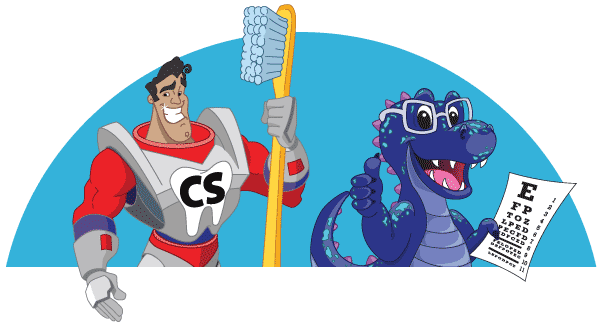Dental
Your Child's Dental Health Timeline

Every parent wants their child to be strong and healthy. Here’s what you need to know to make your child’s teeth healthy at every stage of their development.
Before your child’s first birthday
Good dental health starts before the first tooth comes in. After each feeding—or at least twice a day—gently wipe your baby’s gums with a damp piece of cloth or gauze.
When to start brushing and flossing
Start brushing as soon as your kid gets his or her first tooth. A soft-bristled toothbrush and a very small amount of toothpaste (about the size of a grain of rice) is all you need to get started. From the beginning, brush for two minutes, two times a day.
Once your little one has two teeth next to each other, begin flossing at least once a day.
First visit to the dentist
Once your child’s first tooth appears, it’s time to get to the dentist. This is important in order to be sure the teeth are coming in as they should and to begin getting your baby comfortable with regular dental visits. Find a dentist near you.
One to Three Years Old
By age three, most or all of your little one’s baby teeth should have come in.
It is important to introduce a small amount of fluoride toothpaste after your child’s first birthday. As more teeth come in, flossing becomes more important. Be sure to floss every day!
And, don’t forget to get your child in for dental cleanings and exams two times per year.
Three to Six Years Old
By now, all baby teeth are in and flossing becomes even more important. You can also start using more fluoride toothpaste—about the size of a pea on the toothbrush at age three. Consult with your child’s dentist for the recommended amount of toothpaste.
What to watch for
While your little one still has baby teeth, preventing tooth decay is important. Keeping decay away helps protect baby teeth and establishes healthy hygiene habits—plus, it helps protect adult teeth from decay. Many parents don’t know that decay in baby teeth can damage adult teeth even before they come in, causing problems later on.
For this age group, it is common for little ones to use pacifiers or suck thumbs. Typically, children will stop sucking sometime between ages two and four. To avoid problems with growth and tooth alignment, it is recommended that parent try to break these habits before permanent teeth come in.
Six to Twelve Years Old
Most children have 20 baby teeth—which are replaced in the years between six and twelve or thirteen by 32 adult teeth. Beginning around age six, your child will start losing baby teeth. Typically, the first adult teeth to come in are the first molars—which aren’t replacing baby molars, they are “extra” adult teeth. After the first molars, adult teeth will typically come in from front to back.

Sealants to the rescue!
In addition to brushing and flossing, sealants can help keep your kid’s teeth clean and protect from cavities. Sealants protect the chewing surface of molars and can keep cavities from forming—they can even stop the early stages of tooth decay from becoming a cavity.
Sealants are so effective, in fact, that they prevent 80 percent of cavities in back teeth (where nearly all cavities occur). Children without sealants are three times more likely to have cavities in molars than kids with sealants.
Meet the orthodontist
By age seven, the American Academy of Orthodontists recommends every child have an orthodontic consultation. An orthodontist can identify:
- Any oral development issues
- If your child has enough room for all adult teeth
Issues like this are much easier to treat early, so getting an orthodontic consultation can help prevent bigger problems down the road. Find an orthodontist near you.
Tweens and Teens
Cavities can develop at any time. Reinforcing healthy hygiene habits and seeing the dentist regularly is important from ages 12 and up.
Keeping Teeth Clean with Braces
For children with braces, hygiene habits are even more important because it is more difficult to thoroughly clean with braces on the teeth. Find a toothbrush designed for braces, reinforce flossing habits and use toothpaste that kills germs between and around brackets.
Sports and Teeth
Protecting your child’s teeth while playing sports can help protect against injuries. Mouth guards and helmets are recommended for many sports—consult with your child’s dentist or read this article for more information.
Get great care that lasts a lifetime. Find a dentist for your child now.

